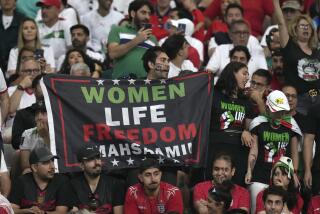Africa toots its own horn in World Cup
- Share via
Reporting from Johannesburg, South Africa -- The soundtrack of this summer’s World Cup will be played on a cheap yard-long plastic horn capable of just a single note — a thudding B flat.
Played alone, it sounds like an elephant. Play a few dozen in concert, and it sounds like a swarm of angry bees.
But put 90,000 of them together in the enclosed space of a World Cup stadium for two hours? Well, then you have a potential health hazard.
“They can really hurt your ears,” says South Africa soccer fan Candice Meyer, a vuvuzela tooting just behind her.
“People from outside aren’t used to this,” agrees another Johannesburg fan, Trevor Bongani. “It could be a problem.”
Yet after months of debate, World Cup officials recently turned a deaf ear to complaints from opposing teams and public safety officials and gave their blessing to the ubiquitous South African horns, guaranteeing, according to Danny Jordaan, chief executive of the local organizing committee, “the noisiest World Cup ever.”
So noisy, viewers at home might want to watch the games with the volume turned down.
“My first thought was ‘Wow.’ It is a remarkable sound,” said Jed Drake, who oversaw ESPN’s coverage of last summer’s Confederations Cup in South Africa and will do the same with the network’s World Cup broadcasts. “Boy oh boy was it loud.”
How loud? About as loud as a jet engine at full throttle. And louder than a NASCAR race, a rock concert or a jackhammer, according to researchers who studied the noise level at a South African Premier League match and found it peaked at 144 decibels.
The U.S. government considers two hours of exposure to anything over 100 decibels to be dangerous.
“Just the buzz, you can’t even talk, they’re so loud,” says U.S. defender Jonathan Bornstein, who has played half a dozen matches in South Africa over the last year. “It’s even sometimes hard to think. Cause it’s like raaaawwwww.”
The vuvuzelas will be part of the World Cup because they’re as much a part of soccer tradition in South Africa as bongo drums and chants are in other countries, tournament organizers said. Which is true if you believe soccer tradition in South Africa began about the time Nelson Mandela got out of prison and not 150 years ago, when the sport was first introduced by British soldiers.
Although the instrument’s history is a little fuzzy, some here say the vuvuzela was inspired by the kudu horn African villagers once used to summon neighbors. But they didn’t reappear in South African until around 1990, and they didn’t become popular at soccer stadiums until the end of the decade.
Not everybody buys that timeline, however.
“The vuvuzela is embedded in South African soccer culture,” insists Firdoze Bulbulia, director of an entertainment company based in Johannesburg. “It is like the drums or the wave for fans from Latin American or Europe.”
Brandon Bernardo, a young Johannesburg musician, agrees.
“Every country has its way of hosting a football game, and a football game in South Africa without a vuvuzela is like having a barbeque without sausage,” he says. “It just doesn’t feel right.”
No one questions that vuvuzelas first came to the outside world’s attention — loudly —during last summer’s Confederations Cup, something of a scaled-down dress rehearsal for this summer’s tournament.
Opposing teams said they couldn’t communicate over the incessant horns, but FIFA, the governing body for intentional soccer, wouldn’t listen to their complaints, saying banning the horns would “Europeanize” the first World Cup on African soil.
“I don’t have the horn two feet from my ear, so I’m OK,” U.S. defender Jay DeMerit said. “Once you’re in the game it kind of drowns out. You do hear it in the fact that you can’t hear other things.”
Wednesday was South Africa’s first “National Day of the Vuvuzela.” And at noon shopkeepers, bank tellers and restaurant customers all paused from what they were doing and blew on a vuvuzela for a very noisy 10 minutes or so.
The vuvuzelas won’t be South Africa’s only cultural contribution to this World Cup. The Diski, an indigenous version of the Macarena in which dancers mimic soccer players, has spread across the country like wildfire in recent months. And the makers of the ornate and kitschy makarapa fan helmet were forced to leave their township workshop and move to a factory to meet the growing demand for their elaborate headgear, which is made from plastic construction helmets paired with giant sunglasses and sporting team logos and colors.
But it will be the overpowering, inescapable buzzing of the vuvuzelas that will be ringing loudest in soccer fans’ ears over the next month.
“Quite a few South Africans also hate those horns,” says Pedro Espi-Sanchis, a fan from Cape Town. “[But] they have entrenched themselves in soccer tradition, so there must be a good reason for that.”
They don’t have to stay there, though. Nor do they have to limit their contribution to South African culture to sports.
Four years ago, Espi-Sanchis founded the Vuvuzela Orchestra, with seven musicians all playing the plastic horns. Now he’s hoping to use the controversy surrounding the instrument as a way to introduce the world to serious African music.
“I just applied [an] ancient idea to the vuvuzela and the production of chords in an effort to make the whole soccer experience somewhat more musical and rewarding,” he says. “What is particularly distressing to me is that African music is rich beyond belief.
“Yet the millions of soccer fans who watch the World Cup on television might come away with the impression that there is no music in South Africa, but just a very loud and continuous B-flat droning sound.”







